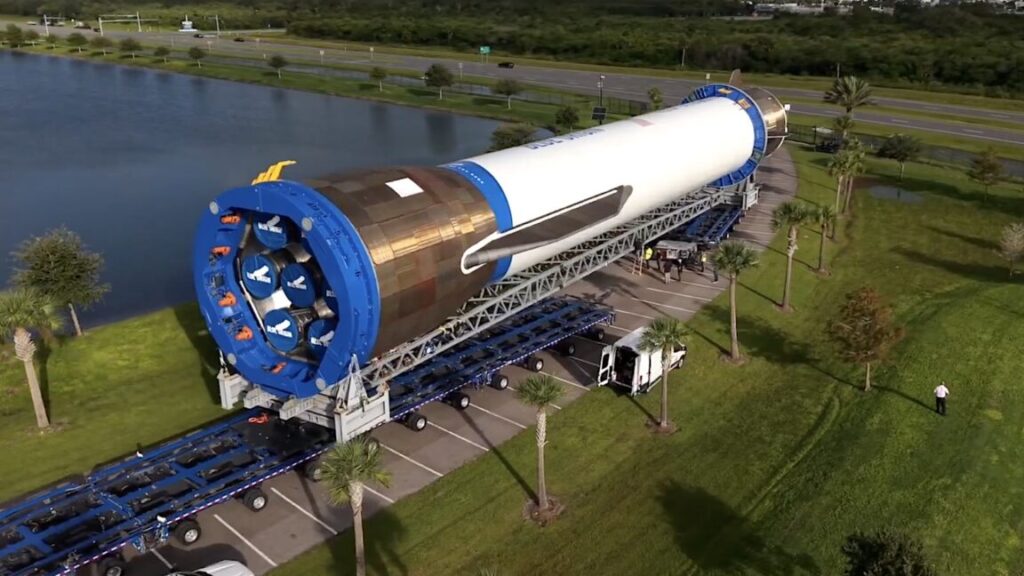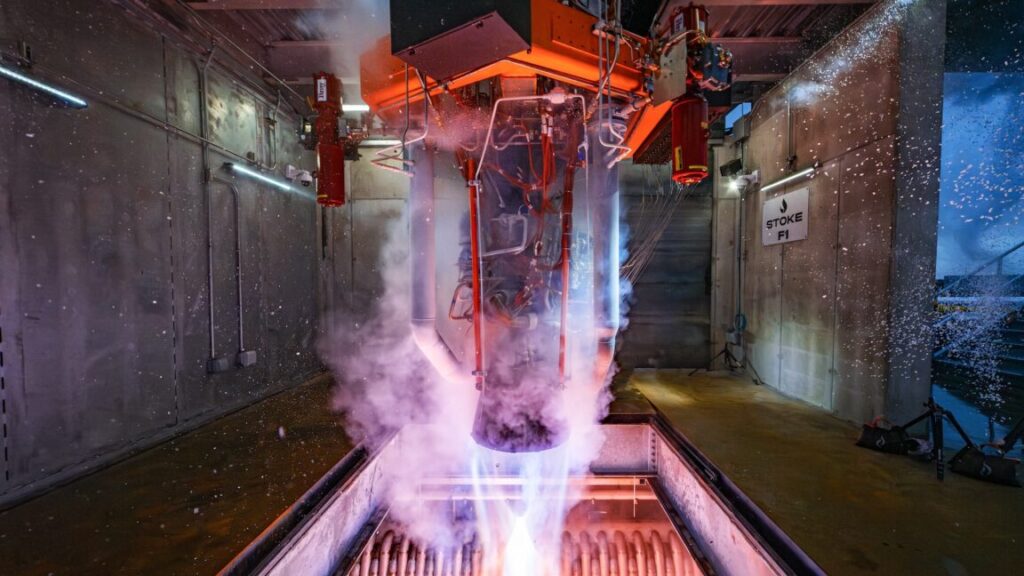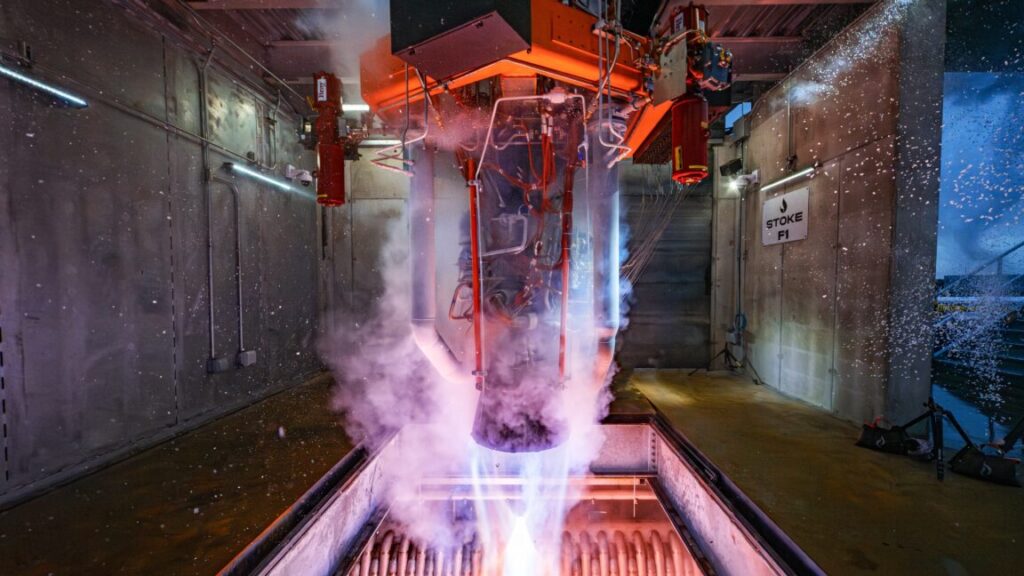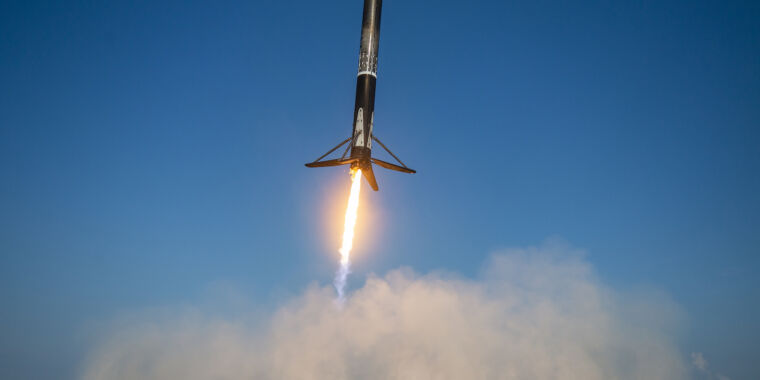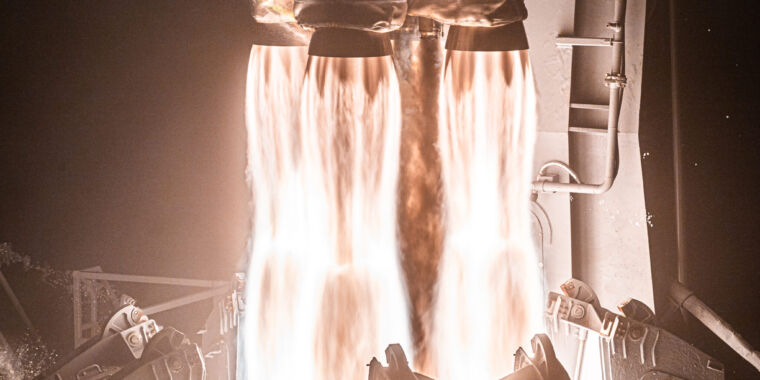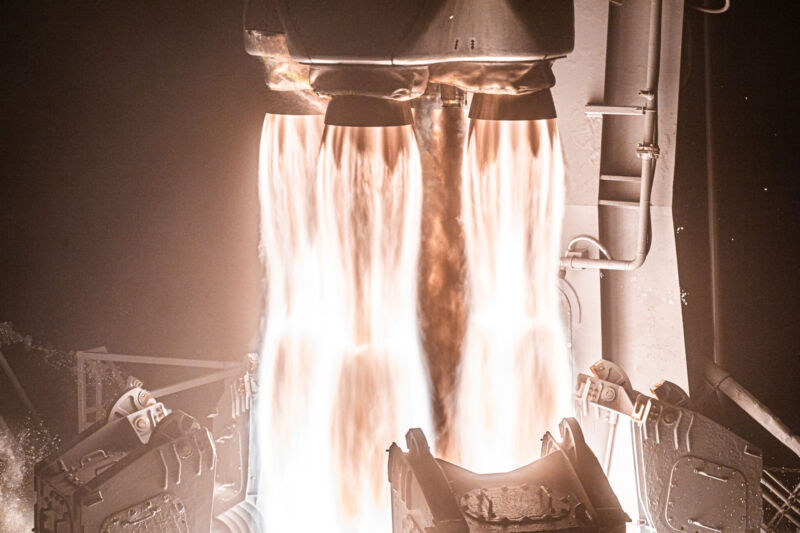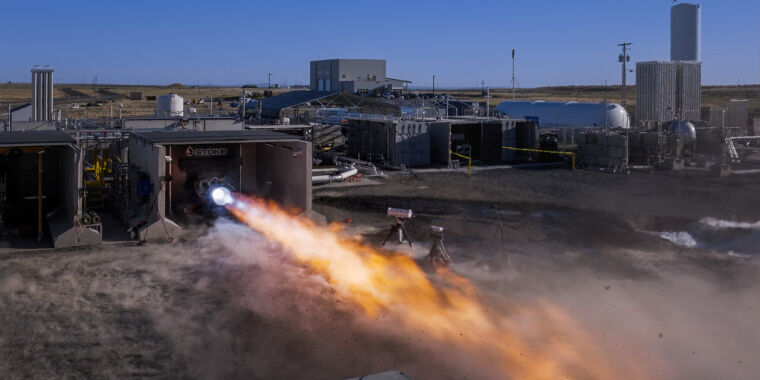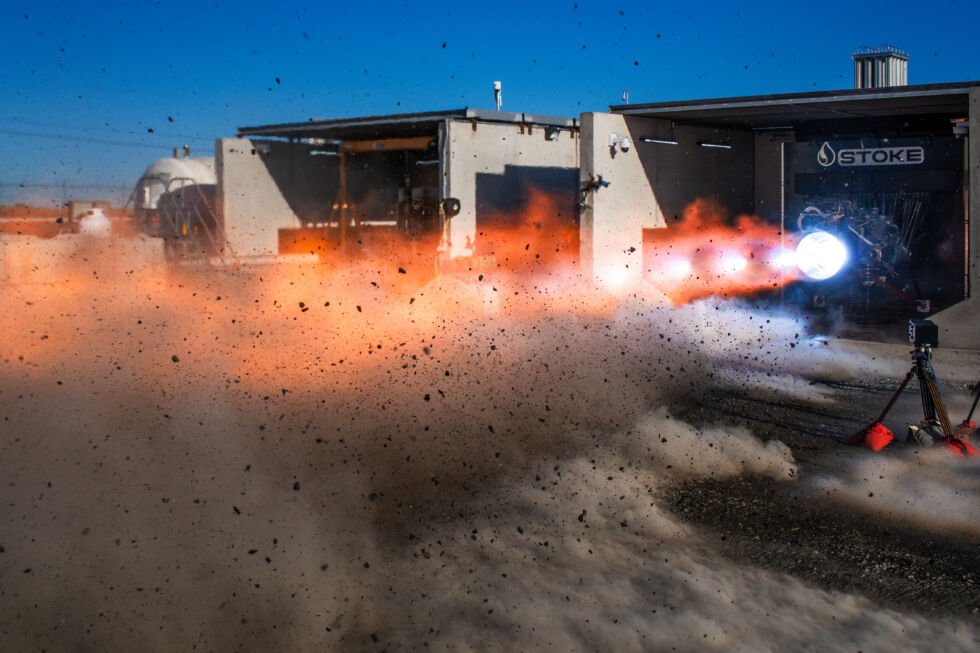Rocket Report: Bezos’ firm will package satellites for launch; Starship on deck
The long, winding road for Franklin Chang-Diaz’s plasma rocket engine takes another turn.
Blue Origin’s second New Glenn booster left its factory this week for a road trip to the company’s launch pad a few miles away. Credit: Blue Origin
Welcome to Edition 8.14 of the Rocket Report! We’re now more than a week into a federal government shutdown, but there’s been little effect on the space industry. Military space operations are continuing unabated, and NASA continues preparations at Kennedy Space Center, Florida, for the launch of the Artemis II mission around the Moon early next year. The International Space Station is still flying with a crew of seven in low-Earth orbit, and NASA’s fleet of spacecraft exploring the cosmos remain active. What’s more, so much of what the nation does in space is now done by commercial companies largely (but not completely) immune from the pitfalls of politics. But the effect of the shutdown on troops and federal employees shouldn’t be overlooked. They will soon miss their first paychecks unless political leaders reach an agreement to end the stalemate.
As always, we welcome reader submissions. If you don’t want to miss an issue, please subscribe using the box below (the form will not appear on AMP-enabled versions of the site). Each report will include information on small-, medium-, and heavy-lift rockets, as well as a quick look ahead at the next three launches on the calendar.

Danger from dead rockets. A new listing of the 50 most concerning pieces of space debris in low-Earth orbit is dominated by relics more than a quarter-century old, primarily dead rockets left to hurtle through space at the end of their missions, Ars reports. “The things left before 2000 are still the majority of the problem,” said Darren McKnight, lead author of a paper presented October 3 at the International Astronautical Congress in Sydney. “Seventy-six percent of the objects in the top 50 were deposited last century, and 88 percent of the objects are rocket bodies. That’s important to note, especially with some disturbing trends right now.”
Littering in LEO … The disturbing trends mainly revolve around China’s actions in low-Earth orbit. “The bad news is, since January 1, 2024, we’ve had 26 rocket bodies abandoned in low-Earth orbit that will stay in orbit for more than 25 years,” McKnight told Ars. China is responsible for leaving behind 21 of those 26 rockets. Overall, Russia and the Soviet Union lead the pack with 34 objects listed in McKnight’s Top 50, followed by China with 10, the United States with three, Europe with two, and Japan with one. Russia’s SL-16 and SL-8 rockets are the worst offenders, combining to take 30 of the Top 50 slots. An impact with even a modestly sized object at orbital velocity would create countless pieces of debris, potentially triggering a cascading series of additional collisions clogging LEO with more and more space junk, a scenario called the Kessler Syndrome.
The easiest way to keep up with Eric Berger’s and Stephen Clark’s reporting on all things space is to sign up for our newsletter. We’ll collect their stories and deliver them straight to your inbox.
New Shepard flies again. Blue Origin, Jeff Bezos’ space company, launched its sixth crewed New Shepard flight so far this year Wednesday as the company works to increase the vehicle’s flight rate, Space News reports. This was the 36th flight of Blue Origin’s suborbital New Shepard rocket. The passengers included: Jeff Elgin, Danna Karagussova, Clint Kelly III, Will Lewis, Aaron Newman, and Vitalii Ostrovsky. Blue Origin said it has now flown 86 humans (80 individuals) into space. The New Shepard booster returned to a pinpoint propulsive landing, and the capsule parachuted into the desert a few miles from the launch site near Van Horn, Texas.
Two-month turnaround … This flight continued Blue Origin’s trend of launching New Shepard about once per month. The company has two capsules and two boosters in its active inventory, and each vehicle has flown about once every two months this year. Blue Origin currently has command of the space tourism and suborbital research market as its main competitor in this sector, Virgin Galactic, remains grounded while it builds a next-generation rocket plane. (submitted by EllPeaTea)
NASA still interested in former astronaut’s rocket engine. NASA has awarded the Ad Astra Rocket Company a $4 million, two-year contract for the continued development of the company’s Variable Specific Impulse Magnetoplasma Rocket (VASIMR) concept, Aviation Week & Space Technology reports. Ad Astra, founded by former NASA astronaut Franklin Chang-Diaz, claims the vehicle has the potential to reach Mars with human explorers within 45 days using a nuclear power source rather than solar power. The new contract will enable federal funding to support development of the engine’s radio frequency, superconducting magnet, and structural exoskeleton subsystems.
Slow going … Houston-based Ad Astra said in a press release that it sees the high-power plasma engine as “nearing flight readiness.” We’ve heard this before. The VASIMR engine has been in development for decades now, beset by a lack of stable funding and the technical hurdles inherent in designing and testing such demanding technology. For example, Ad Astra once planned a critical 100-hour, 100-kilowatt ground test of the VASIMR engine in 2018. The test still hasn’t happened. Engineers discovered a core component of the engine tended to overheat as power levels approached 100 kilowatts, forcing a redesign that set the program back by at least several years. Now, Ad Astra says it is ready to build and test a pair of 150-kilowatt engines, one of which is intended to fly in space at the end of the decade.
Gilmour eyes return to flight next year. Australian rocket and satellite startup Gilmour Space Technologies is looking to return to the launch pad next year after the first attempt at an orbital flight failed over the summer, Aviation Week & Space Technology reports. “We are well capitalized. We are going to be launching again next year,” Adam Gilmour, the company’s CEO, said October 3 at the International Astronautical Congress in Sydney.
What happened? … Gilmour didn’t provide many details about the cause of the launch failure in July, other than to say it appeared to be something the company didn’t test for ahead of the flight. The Eris rocket flew for 14 seconds, losing control and crashing a short distance from the launch pad in the Australian state of Queensland. If there’s any silver lining, Gilmour said the failure didn’t damage the launch pad, and the rocket’s use of a novel hybrid propulsion system limited the destructive power of the blast when it struck the ground.

Stoke Space’s impressive funding haul. Stoke Space announced a significant capital raise on Wednesday, a total of $510 million as part of Series D funding. The new financing doubles the total capital raised by Stoke Space, founded in 2020, to $990 million, Ars reports. The infusion of money will provide the company with “the runway to complete development” of the Nova rocket and demonstrate its capability through its first flights, said Andy Lapsa, the company’s co-founder and chief executive, in a news release characterizing the new funding.
A futuristic design … Stoke is working toward a 2026 launch of the medium-lift Nova rocket. The rocket’s innovative design is intended to be fully reusable from the payload fairing on down, with a regeneratively cooled heat shield on the vehicle’s second stage. In fully reusable mode, Nova will have a payload capacity of 3 metric tons to low-Earth orbit, and up to 7 tons in fully expendable mode. Stoke is building a launch pad for the Nova rocket at Cape Canaveral Space Force Station, Florida.
SpaceX took an unusual break from launching. SpaceX launched its first Falcon 9 rocket from Florida in 12 days during the predawn hours of Tuesday morning, Spaceflight Now reports. The launch gap was highlighted by a run of persistent, daily storms in Central Florida and over the Atlantic Ocean, including hurricanes that prevented deployment of SpaceX’s drone ships to support booster landings. The break ended with the launch of 28 more Starlink broadband satellites. SpaceX launched three Starlink missions in the interim from Vandenberg Space Force Base, California.
Weather still an issue … Weather conditions on Florida’s Space Coast are often volatile, particularly in the evenings during summer and early autumn. SpaceX’s next launch from Florida was supposed to take off Thursday evening, but officials pushed it back to no earlier than Saturday due to a poor weather forecast over the next two days. Weather still gets a vote in determining whether a rocket lifts off or doesn’t, despite SpaceX’s advancements in launch efficiency and the Space Force’s improved weather monitoring capabilities at Cape Canaveral.
ArianeGroup chief departs for train maker. Current ArianeGroup CEO Martin Sion has been named the new head of French train maker Alstom. He will officially take up the role in April 2026, European Spaceflight reports. Sion assumed the role as ArianeGroup’s chief executive in 2023, replacing the former CEO who left the company after delays in the debut of its main product: the Ariane 6 rocket. Sion’s appointment was announced by Alstom, but ArianeGroup has not made any official statement on the matter.
Under pressure … The change in ArianeGroup’s leadership comes as the company ramps up production and increases the launch cadence of the Ariane 6 rocket, which has now flown three times, with a fourth launch due next month. ArianeGroup’s subsidiary, Arianespace, seeks to increase the Ariane 6’s launch cadence to 10 missions per year by 2029. ArianeGroup and its suppliers will need to drastically improve factory throughput to reach this goal.

New Glenn emerges from factory. Blue Origin rolled the first stage of its massive New Glenn rocket from its hangar on Wednesday morning in Florida, kicking off the final phase of the campaign to launch the heavy-lift vehicle for the second time, Ars reports. In sharing video of the rollout to Launch Complex-36 on Wednesday online, the space company did not provide a launch target for the mission, which seeks to put two small Mars-bound payloads into orbit. The pair of identical spacecraft to study the solar wind at Mars is known as ESCAPADE. However, sources told Ars that on the current timeline, Blue Origin is targeting a launch window of November 9 to November 11. This assumes pre-launch activities, including a static-fire test of the first stage, go well.
Recovery or bust? … Blue Origin has a lot riding on this booster, named “Never Tell Me The Odds,” which it will seek to recover and reuse. Despite the name of the booster, the company is quietly confident that it will successfully land the first stage on a drone ship named Jacklyn. Internally, engineers at Blue Origin believe there is about a 75 percent chance of success. The first booster malfunctioned before landing on the inaugural New Glenn test flight in January. Company officials are betting big on recovering the booster this time, with plans to reuse it early next year to launch Blue’s first lunar lander to the Moon.
SpaceX gets bulk of this year’s military launch orders. Around this time each year, the US Space Force convenes a Mission Assignment Board to dole out contracts to launch the nation’s most critical national security satellites. The military announced this year’s launch orders Friday, and SpaceX was the big winner, Ars reports. Space Systems Command, the unit responsible for awarding military launch contracts, selected SpaceX to launch five of the seven missions up for assignment this year. United Launch Alliance (ULA), a 50-50 joint venture between Boeing and Lockheed Martin, won contracts for the other two. These missions for the Space Force and the National Reconnaissance Office are still at least a couple of years away from flying.
Vulcan getting more expensive … A closer examination of this year’s National Security Space Launch contracts reveals some interesting things. The Space Force is paying SpaceX $714 million for the five launches awarded Friday, for an average of roughly $143 million per mission. ULA will receive $428 million for two missions, or $214 million for each launch. That’s about 50 percent more expensive than SpaceX’s price per mission. This is in line with the prices the Space Force paid SpaceX and ULA for last year’s contracts. However, look back a little further and you’ll find ULA’s prices for military launches have, for some reason, increased significantly over the last few years. In late 2023, the Space Force awarded a $1.3 billion deal to ULA for a batch of 11 launches at an average cost per mission of $119 million. A few months earlier, Space Systems Command assigned six launches to ULA for $672 million, or $112 million per mission.
Starship Flight 11 nears launch. SpaceX rolled the Super Heavy booster for the next test flight of the company’s Starship mega-rocket out to the launch pad in Texas this week. The booster stage, with 33 methane-fueled engines, will power the Starship into the upper atmosphere during the first few minutes of flight. This booster is flight-proven, having previously launched and landed on a test flight in March.
Next steps … With the Super Heavy booster installed on the pad, the next step for SpaceX will be the rollout of the Starship upper stage. That is expected to happen in the coming days. Ground crews will raise Starship atop the Super Heavy booster to fully stack the rocket to its total height of more than 400 feet (120 meters). If everything goes well, SpaceX is targeting liftoff of the 11th full-scale test flight of Starship and Super Heavy as soon as Monday evening. (submitted by EllPeaTea)
Blue Origin takes on a new line of business. Blue Origin won a US Space Force competition to build a new payload processing facility at Cape Canaveral Space Force Station, Florida, Spaceflight Now reports. Under the terms of the $78.2 million contract, Blue Origin will build a new facility capable of handling payloads for up to 16 missions per year. The Space Force expects to use about half of that capacity, with the rest available to NASA or Blue Origin’s commercial customers. This contract award follows a $77.5 million agreement the Space Force signed with Astrotech earlier this year to expand the footprint of its payload processing facility at Vandenberg Space Force Base, California.
Important stuff … Ground infrastructure often doesn’t get the same level of attention as rockets, but the Space Force has identified bottlenecks in payload processing as potential constraints on ramping up launch cadences at the government’s spaceports in Florida and California. Currently, there are only a handful of payload processing facilities in the Cape Canaveral area, and most of them are only open to a single user, such as SpaceX, Amazon, the National Reconnaissance Office, or NASA. So, what exactly is payload processing? The Space Force said Blue Origin’s new facility will include space for “several pre-launch preparatory activities” that include charging batteries, fueling satellites, loading other gaseous and fluid commodities, and encapsulation. To accomplish those tasks, Blue Origin will create “a clean, secure, specialized high-bay facility capable of handling flight hardware, toxic fuels, and explosive materials.”
Next three launches
Oct. 11: Gravity 1 | Unknown Payload | Haiyang Spaceport, China Coastal Waters | 02: 15 UTC
Oct. 12: Falcon 9 | Project Kuiper KF-03 | Cape Canaveral Space Force Station, Florida | 00: 41 UTC
Oct. 13: Starship/Super Heavy | Flight 11 | Starbase, Texas | 23: 15 UTC

Rocket Report: Bezos’ firm will package satellites for launch; Starship on deck Read More »
